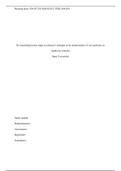Graphs, Proportionality, and Units
Dimension: A measurable extent of some kind.
1D: One variable.
2D: Two variables. When each dimension is multiplied by
3D: 3 variables. itself, it is squared.
Proportionality: How two variables related to one another.
Unrelated: No association.
Related: Associated, but non specific.
Directly: What happens to one, happens to the other.
Indirectly: What happens to one, the opposite happens to the other.
Reciprocals: Always inverse. When multiplied together = 1.
Units: Required for a numerical answer.
Time: Duration of one point to another.
Distance: Length from one point to another.
Percentages: Unitless. Calculation of part over the whole.
The Metric System
Billions: Giga (G) 10 ⁹ 1,000,000,000 Billionths: Nano (n) 1/1000000000
Millions: Mega (M) 10⁶ 1000000 Millionths: Micro (µ) 1/1000000
Thousands: Kilo (K) 10ᵌ 1000 Thousandths: Milli (m) 1/1000
Hundreds Hecto (H) 10² 100 Hundredths Centi (c) 1/100
Tens: Deca (da) 10 10 Tenths: Deci (d) 1/10
Scientific Notation
Large Numbers:
1. Assume the decimal point is at the end.
2. Move the decimal to just after the first whole number.
3. Write the new number, rounded to 2 decimal places.
4. Multiply by 10 to a positive exponent.
5. Exponent = number of decimal places moved.
Small Numbers:
1. Move the decimal to just after the first whole number.
2. Write the new number, rounded to 2 decimal places.
3. Multiply by 10 to a negative exponent.
4. Exponent = Number of decimal places moved.
,tiplied by
1/1000000000
1/1000000
1/1000
1/100
1/10
,Ch2: Sound.
Sound Waves
Transfer energy, not matter.
Energy Property of matter manifesting as a capacity to do work.
Carried by all waves.
Media Biological tissue. Must be present for energy transfer.
Sound cannot travel in a vacuum (devoid of matter).
Acoustic Variables: Quantities within a soundwave (Y) that vary in space or time (X)
Pressure Concentration of force in an area. Pascals (Pa)
Density Concentration of mass in a volume. Kg/cm(3)
Particle Motion Measurement of distance. mm
Characteristics: Sound is both mechanical and longitudinal.
Mechanical: Sound travels via Particle Motion. Particles within beam excite, return.
Compression: More particles Peak.
Rarefaction: Less particles Trough
Longitudinal: Particles move parallel to the direction of sound.
Interference: Two waves in the same place at the same time.
Constructive: In-Phase. Amplifies.
Destructive: Out-of Phase. Abolishes.
,or time (X)
xcite, return.











